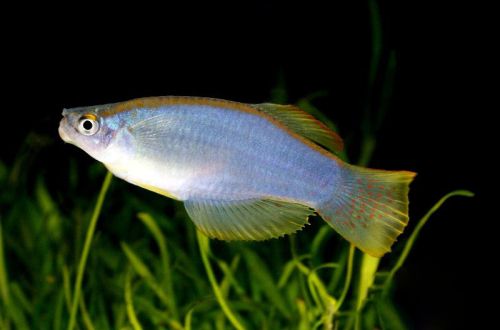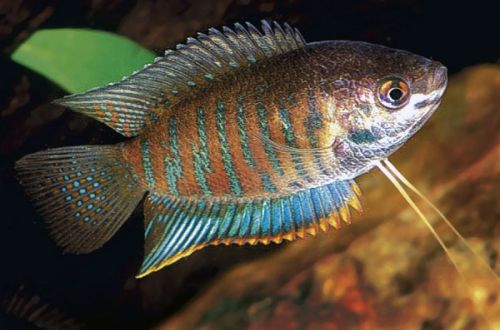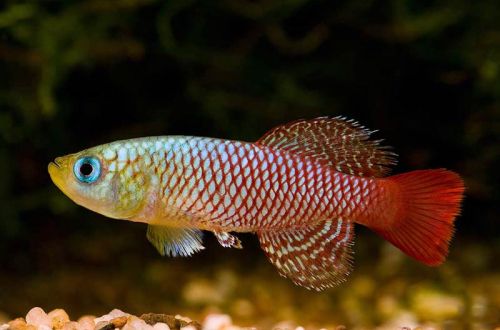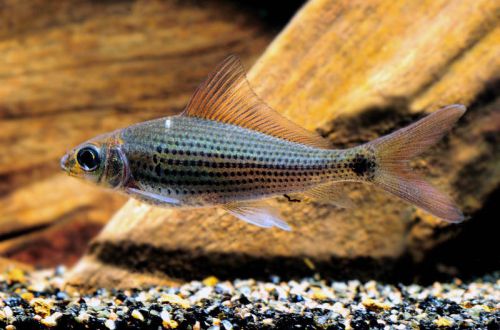
Nigerian Lampeye
The Nigerian or Iridescent Lampeye, scientific name Procatopus similis, belongs to the Poeciliidae family. Modest in its size, the fish compensates for this with a bizarre iridescent body paint of various colors. This species is able to decorate any aquarium with itself, however, its maintenance requires a certain amount of experience, therefore it cannot be recommended for beginner aquarists.

There are many used names of this fish and none of them is the main one, each country has its own preferences. In Russia, the transcription of the Latin name is often used – Procatopus Similis. But it is worth noting that sellers may simply not know what kind of fish it is and sell it under a different name, for example, as one of the Guppy varieties, since they belong to the same family. Such a mistake will be costly due to different needs for water quality and content.
Habitat
This species was discovered by European researchers in 1927 during the study of flora and fauna in the colonial possessions of Central Africa. Fish are found in fast-moving coastal and lowland rivers and streams in the territory of the modern states of Nigeria, Equatorial Guinea and neighboring countries. They feed on insect larvae, small aquatic crustaceans, river worms, etc.
Description
A small fish, reaches a length of about 6 cm, the body is elongated with a slightly arched back. The head is flattened from above, the structure of the mouth is adapted to capture food from the surface. A small spike is visible on the underside of the gill cover. The fins are rounded, the dorsal is located towards the tail.
There is a bright point on the eye that reflects light, from which a sensation of glow is created, which gave the name to this species. The color is iridescent, with smooth transitions from one color to another. On most of the body, the coloration is blue-green, which fades to pale white on the abdomen. A red stripe runs along the back, continuing on the tail. The tail is yellowish or blue with a scattering of dark points. Males are more expressive than females.
Food
A carnivorous species, a variety of fresh or frozen meat products, such as brine shrimp, bloodworms or mosquito larvae, should be provided in abundance in the home aquarium.
Maintenance and care
Maintenance causes difficulties mainly due to the need to maintain high quality and purity of water. Iridescent Lampeye is extremely sensitive to this. A high performance filter along with a weekly 30% water part renewal is a must. In addition, leftover food should be removed after each feeding to prevent contamination from decomposition products.
The filtration system will provide the necessary flow in the aquarium. An aerator with several spray stones will help maintain a sufficient level of oxygen. Other important equipment is a heater and a lighting system.
In the design, a dark substrate is preferable; against its background, the fish will stand out favorably. Any soil that can be easily cleaned with a siphon, for example, small pebbles or coarse sand. Plants should be planted in separate pots to avoid damage to the roots from constant cleaning of the soil. Floating plants will prevent attempts to jump out of the tank (all Killy fish are prone to this), but a lid with this function works much better.
Social behavior
A peaceful and even timid species, it gets along well with other calm fish that can live in similar conditions of constant water movement. Important – the content in the group is not less than 6 individuals.
Breeding / breeding
Breeding at home is extremely difficult, there is no single reliable way to push them to spawn. If there is a desire to do this, we recommend that you seek the help of specialized breeders.
Diseases
Not the hardiest kind. The slightest changes in water quality immediately affect the well-being of fish, bacterial infections are the most common. For more information on symptoms and treatments, see the Aquarium Fish Diseases section.





